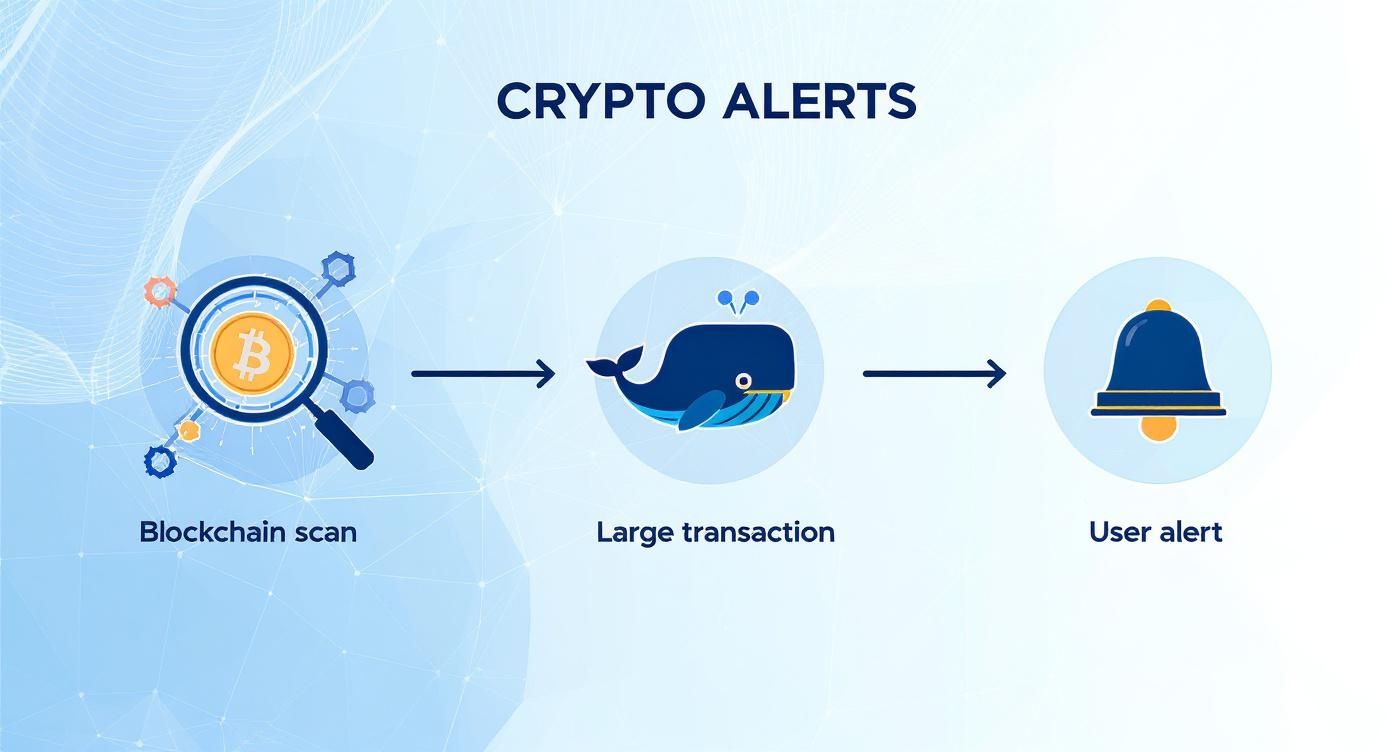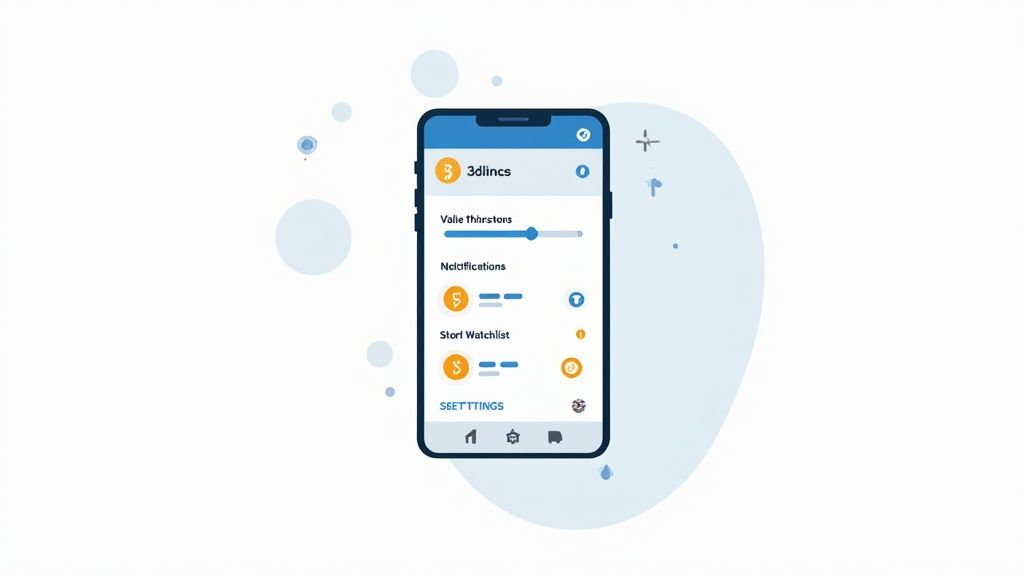Smart Contract Security: An Actionable Guide
Master smart contract security with practical guidance on vulnerabilities, secure coding practices, and the tools you need to protect your dApps.

November 11, 2025
Wallet Finder

November 12, 2025

A whale alert app is a powerful tool that scans public blockchains for large cryptocurrency transactions, notifying you when it detects significant movements. In crypto, "whales" are individuals or entities holding substantial amounts of a specific coin. Their actions can create significant market waves, making a whale alert app an essential part of any serious trading strategy.
Imagine trying to predict a hurricane just by looking out your front door. You might see wind and rain, but you'd be completely unaware of the massive storm system brewing offshore.
Trading crypto without a whale alert app is similar. You see price fluctuations, but you're blind to the huge capital flows happening behind the scenes that drive those changes. A whale alert app is your market radar, offering a direct view of major on-chain capital movements. It transforms a flood of raw data into simple, actionable intelligence, helping you understand the why behind price action instead of just reacting to it.
Interestingly, the concept of a "whale alert" didn't start in finance. The first Whale Alert app was launched in North America in 2012 to help prevent large ships from colliding with actual whales, a leading cause of whale mortality. By 2025, it was active in European waters, protecting whales from over 2 million vessels annually. The principle is the same: track massive, impactful entities to avoid costly disasters.
In the crypto world, these apps perform a similar function for digital assets. They monitor public ledgers for transactions exceeding a specific threshold, like $1 million in Bitcoin or Ethereum. When a large transaction occurs, you get an alert. This provides a significant advantage:
Ultimately, a whale alert app bridges the gap between complex blockchain data and informed trading decisions, empowering you to become a proactive analyst who understands the forces shaping the market.
This table provides a quick overview of the essential functions of a whale alert app and their benefits for traders.
Each function is designed to give you a specific edge, helping you move from reacting to the market to anticipating it.
Ever wondered how a whale alert app knows about a massive transaction the second it happens? It’s not magic—it's a direct connection to the blockchain's core. Public blockchains like Bitcoin or Ethereum are transparent, global ledgers, constantly updated and open for anyone to inspect.
These apps act as tireless digital auditors, continuously scanning this public record. Their primary job is to identify transactions that meet a specific, high-value threshold—for instance, any crypto movement exceeding $1 million. This process filters a chaotic stream of data into a clean, simple notification delivered directly to you.
The visualization below illustrates this powerful process, from the initial blockchain scan to the final alert you receive.

This flow demonstrates how raw, on-chain events are transformed into actionable intelligence, bridging the gap between blockchain activity and a trader's screen.
So, how does an app actually "read" the blockchain? The process relies on several key technologies working in unison. It begins with blockchain nodes—computers distributed globally, each holding a complete copy of the blockchain's history.
A whale alert app connects to these nodes to receive a real-time feed of every new transaction. This raw data contains essential details, but it's often cryptic and difficult to interpret on its own.
Key Takeaway: The foundation of any reliable alert is direct access to blockchain nodes. This guarantees the data is unfiltered, accurate, and pulled straight from the decentralized source, not some third-party middleman.
To make sense of this data flood, these apps utilize a few crucial tools:
Flagging a large transaction is only the first step. The raw data—a jumble of alphanumeric strings representing wallet addresses and amounts—lacks context and is not very useful for a trader.
This is where a good whale alert app proves its value. It enriches the raw data by cross-referencing wallet addresses with databases of known entities. For example, it might identify that a large amount of Tether (USDT) was just sent to a wallet known to belong to a major cryptocurrency exchange.
This enrichment process turns a simple data point into a powerful insight. Instead of just seeing that $10 million moved, you now know that $10 million moved to an exchange, which could signal an intent to sell. Understanding this technical pipeline helps you trust the signals you receive and use them to make smarter decisions.

Receiving a ping from a whale alert app is just the starting point. The real skill lies in interpreting the signal and deciding how to act. Let's explore three practical trading strategies you can implement using these on-chain insights.
These strategies are about adding context to a single data point—a large transaction. Think of each alert as a clue; your job is to read between the lines and anticipate what might happen next.
One of the most direct ways to use whale alerts is to catch early momentum in smaller altcoins. When you observe a series of large buys flowing into a lesser-known token from private wallets, it’s a strong indication that smart money may be building a position.
Actionable Steps:
Trader's Insight: The key here is confirmation. Don't rely on the on-chain data alone. Combining on-chain signals with social sentiment and market data provides a much stronger basis for a trade.
Watching stablecoin movements is another powerful strategy. When you receive alerts for large amounts of USDT, USDC, or other stablecoins moving onto major exchanges, it often means whales are preparing to buy. They are loading their accounts with "dry powder" to deploy into the market.
Actionable Steps:
Whale alerts are not just for offensive plays; they are an essential defensive tool. A large transfer of a token from an exchange to a private wallet is generally a bullish long-term signal, suggesting an intent to HODL and reducing available supply.
The major red flag is the opposite: large sums moving onto exchanges. This often precedes a significant sell-off.
Actionable Steps:
In the real world, tracking apps help ships avoid collisions that are estimated to kill around 20,000 whales each year. In crypto, a good whale alert app helps you navigate equally dangerous market waters. By understanding the story behind the signal, you can turn raw data into a much smarter trading plan.
If you want to go deeper on this topic, check out our guide to analyzing whale wallets for market signals.

Diving into on-chain data can feel overwhelming. A well-configured whale alert app acts as your filter, cutting through the noise to deliver high-signal intelligence. The goal is to build a personalized system that serves you actionable information, not spam. A generic setup will drown you in irrelevant notifications, while a fine-tuned system acts as your personal on-chain analyst.
First, select a reliable whale alert app. Look for one that offers powerful filtering options, real-time alerts, and a user-friendly interface.
Once you have your app, the most crucial first step is setting a minimum transaction value. By setting a high threshold—such as $500,000 or $1 million—you immediately filter out over 99% of blockchain chatter. This ensures you are only notified of moves large enough to genuinely impact market liquidity and sentiment.
Next, it’s time to create a focused feed by building watchlists for the specific assets and wallets you care about.
This is where you refine your system to match your trading style. A good setup might include:
Pro Tip: Don't just watch individual tokens. Pay close attention to large stablecoin movements, especially to and from major exchanges. A massive wave of USDT flowing into Binance is often a powerful hint that broad market buying is about to kick off.
By dialing in these settings, your whale alert app transforms from a noisy distraction into a precision intelligence tool, delivering a curated feed of market-moving events directly relevant to your trades.
Getting a ping from a whale alert app can feel like an insider tip, but acting impulsively on raw data is a recipe for costly mistakes. Not every large transaction is a signal to buy or sell. Much of what you see is operational noise—large entities conducting digital housekeeping that has no bearing on the market's next move.
The key skill is learning to distinguish a genuine market-moving signal from a false positive. If you mistake an exchange shuffling funds between its own wallets for a massive buy, you're trading on flawed information. You must look beyond the dollar amount and investigate the context behind the transaction.
The most common mistake traders make is misinterpreting the context of a transaction. A whale alert app tells you the "what"—a large transfer occurred. It's your job to determine the "why." Skipping this step is like trading with a blindfold on.
Here are the most common sources of false signals:
Key Insight: The context of a transaction is always more important than its size. A $1 million buy from a private wallet that lands on an exchange is often a far more powerful signal than a $100 million transfer between two known exchange addresses.
To avoid these traps, ask critical questions before placing a trade. Is this a known exchange wallet? Where is the money going? Is this a one-off move or part of a larger pattern? Using tools that offer advanced filters for whale wallet tracking can help you automate this process.
Having a mental framework for different transaction types can help you quickly assess an alert and decide if it's actionable. Use the table below as a cheat sheet for decoding whale movements.
By learning to read these nuances, your whale alert app evolves from a simple notification service into a powerful analytical tool.
Diving into on-chain data often brings up questions. Here are answers to some of the most common ones traders have about using whale alert apps.
Yes and no. The data reported by these apps is extremely accurate. If $10 million moves on the blockchain, the app will report that $10 million transaction precisely. The data is a direct reflection of on-chain activity.
However, data accuracy is not the same as interpretation accuracy. The app tells you what happened (10,000 ETH moved from Wallet A to Wallet B), but it can't tell you why. Was it a genuine buy, an internal exchange transfer, or fund consolidation?
So, while the transaction data is reliable, interpreting its meaning is your responsibility. The app provides the facts; a skilled trader uncovers the story behind them.
No. A whale alert app is a powerful tool, but it's not a magic money printer. Relying solely on these alerts is like driving a car while only looking at the speedometer—you know your speed, but you have no awareness of the road ahead.
Successful trading requires a combination of strategies:
Key Takeaway: Use whale alerts to confirm your trading ideas or to get an early warning of significant market events. Never use an alert as the sole reason for a trade. Relying on a single signal often leads to emotional and reactive decision-making.
This is a common point of confusion. The relationship is simple:
Think of on-chain analysis as being a city planner, looking at comprehensive data like traffic flow and population trends. A whale alert is like the police scanner blaring about a major bank heist—a single, high-impact event within the larger dataset. A whale alert app is your focused entry point into the broader world of on-chain analysis.
Following a single, successful wallet can provide invaluable insights. The process is straightforward:
By focusing on a proven player, you can observe their strategy in real time, giving you a powerful edge in your own trading.
Ready to move beyond generic alerts and start tracking the wallets that actually move the market? Wallet Finder.ai gives you the tools to discover, analyze, and mirror the strategies of top-performing crypto traders in real time. Start your 7-day trial and turn on-chain data into your competitive advantage.
"I've tried the beta version of Walletfinder.ai extensively and I was blown away by how you can filter through the data, and the massive profitable wallets available in the filter presets, unbelievably valuable for any trader or copy trader. This is unfair advantage."
.avif)
Pablo Massa
Experienced DeFi Trader